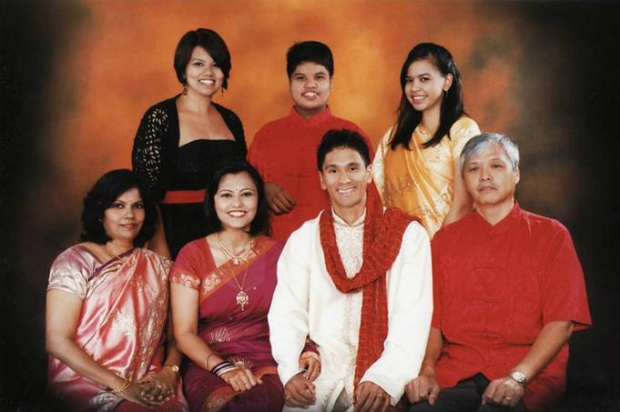The Chindian Diaries: Love knows no cultural bounds
CURIOSITY about his own heritage led Kevin Bathman to document and learn about Chindians, a once taboo subculture that straddles two distinct worlds. Kevin’s project, The Chindian Diaries aims to capture their stories. Beatrice Foong reports.
On a certain day in June 2012, Kevin Bathman wandered into a weekend storytelling workshop that focused on tracing ancestral roots. He left with a new-found passion to document and discover more about the meaning of being a ‘Chindian’ (a Chinese-Indian), which eventually led to the founding of the Chindian Diaries project.
“When I embarked on this project, I never realized that I would be meeting other Chindians like myself, let alone helping to write their stories. The Chindian Diaries project aims to capture the forgotten stories of both cultures and to find current stories of interracial Indian and Chinese couples.”
The Chindian Diaries has garnered more than 2,000 ‘likes’ on Facebook, with Kevin at the helm actively sharing news, stories and photos of the Chindian community. Notably, it has allowed the Chindian community, and others from a mixed background to share their stories among themselves and the wider public.
Belonging to two distinct cultures makes you more sensitive towards racial issues. I find those who have come from a mixed background are able to see both sides of the coins, as they are neither race A or race B but a combination of both.” – Kevin Bathman
With globalisation helping to bring different peoples together, Kevin says that inter-racial marriages are bridging a gap in cultural understanding. However, he admits that many Chindians sometimes find the experience of straddling two cultures similar to having “an identity crisis”.
“Belonging to two distinct cultures makes you more sensitive towards racial issues. I find those who have come from a mixed background are able to see both sides of the coins, as they are neither race A or race B but a combination of both.”
Kevin also noted that “compared to [what his] grandparents had to endure in the ’30s and ’40s, society today has at least matured and mixed marriages have become acceptable”. Others who participated in the project feel similarly.
In many Southeast Asian countries, interracial marriages occurred naturally as a result of the policies implemented under colonial rule. The aftermath of Britain’s occupation in Malaysia instituted economic segregation based on ethnicity which is still seen in the country today.
“I used to be bothered by the fact that my Identity Card in Malaysia denoted my race as Indian. I didn’t like the fact that my Chinese culture wasn’t acknowledged. It’s like ignoring half of who you are. In Malaysia, you need to record your father’s race in official papers as your own, following the paternalistic traditions of the British era.”
“I am a big advocate for dual race recognition on the Malaysian identity forms. Singapore has officially allowed dual race in IC and birth certificates since 2010.”
“A local Malaysian MP, Hannah Yeoh has tried to register her child as ‘Anak Malaysia’ (Child of Malaysia) instead of the usual dogmatic race in forms. She hasn’t succeeded but it has at least brought attention to the issue.”
A cross-cultural romance
Mitasha Yu, who is of Indian heritage, relates her story of a cross-cultural love that has spanned for 13 years, following a year and a half of marriage to her husband of Chinese descent.
“My parents are second generation Indians and my husband’s parents are first generation Chinese. I think because both my husband and I grew up in a Western, multicultural society so we are very open to other cultures and races.”
We live and interact amongst so many different cultures and religions, learning and developing as a result.” – Mitasha Yu
“Initially there was some resistance from my parents when they found out about us being together – but I think this was a combination of us being too young as I was only 16, and also the issue of culture and religion being passed onto our children.”
“In fact, my parents did try and set me up with some eligible Indian bachelors early on, but soon realised that I was serious about my relationship and I was happy. I think it’s something everyone wants to be able to do – pass down their culture and religious beliefs to their children. Being a strong Hindu, this certainly was something that required lengthy discussions before marriage with my husband, as he is agnostic.”
“I have Indian friends who have married outside their culture and religion, and have had their family oppose the marriage. I don’t understand why families will persevere with such behaviour.”
“We live and interact amongst so many different cultures and religions, learning and developing as a result. We don’t live in a monochromatic society where the chances of meeting someone from the same culture and religion that you have a connection with are relatively low.”
“I think it is very unrealistic to expect this of your children, we should learn to be open to and accept other cultures into our lives.”
For Mitasha, her cross-cultural marriage has helped to reaffirm shared values between the different communities.
“I got to learn more about the Chinese culture when preparing for our wedding. I actually found many similarities between the Chinese and Indian cultures. For example, red is an auspicious colour especially for weddings, so wearing red wedding clothes tied in with both cultures. Both Indian and Chinese cultures are collectivist cultures so filial piety is a common priority. Even the word for tea is similar between the two.”
For more information on Kevin Bathman’s project, visit The Chindian Diaries’ Facebook page.




